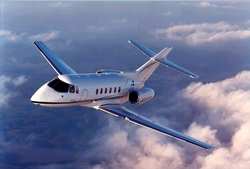But NBAA Says The Large Aircraft Security Program Proposal Had
A Silver Lining
At NBAA’s 2008 Annual Meeting & Convention in Orlando,
FL, the top GA manager for the TSA assured NBAA Members that new
security regulations planned by TSA officials would not be onerous.
“She told us that ‘everything will be stuff
you’re already doing,’” recalls NBAA Vice
President, Safety and Security Doug Carr. “Then, two days
later, TSA released its Large Aircraft Security Program [LASP], and
after we read it, we wondered if it was the same document she had
been referring to.”

LASP called for flight crew security threat assessments and
police background investigations, a check of passengers against two
TSA watch lists on every flight, an armed security officer on board
and creation of an individual flight security program by each
company. “Also, in many cases it would have prohibited
companies from carrying their own products,” said Greg Kulis,
a business aircraft pilot who is now chair of NBAA’s Security
Council. “It would have mandated hiring a third-party safety
plan auditor and the 12,500 pound weight limit would have caught
many single-pilot light aircraft owners.”
Adding financial insult to injury, TSA officials estimated an
annual compliance cost to each operator of between $12,259 and
$28,356.
When the LASP Notice of Proposed Rule Making (NPRM) was
published in the Federal Register, the public comment period was to
have been a government-standard 60 days, but NBAA analysts knew
that wouldn’t be enough. NBAA and the AOPA won an extension
of the comment period, until February of 2009, and during that
period TSA received an unprecedented 7,400 comments vehemently
opposed to LASP.
To their credit, once TSA officials realized the depth of
opposition, the agency scheduled five LASP public hearings across
the country and NBAA participated in every one. Between 1,200 and
1,500 concerned NBAA members crowded each meeting, and made sure
TSA officials at the head table in each meeting understood the
real-world effect such security measures. “It really
highlighted the degree to which business aviation is such a key
element of the economy,” said Carr.

In short, explained NBAA President and CEO Ed Bolen, “TSA
was proposing to overlay big-airline security onto tens of
thousands of small businesses, and it just wouldn’t
work.”
At the public meeting at Westchester County Airport near White
Plains, NY, Bolen took the agency to task for its erroneous
definition of “large aircraft” in the LASP plan.
“A 12,500 pound aircraft, from windshield to rear bulkhead,
would fit turned sideways in any of the three aircraft hijacked
during 9/11,” he said. “It’s less than one tenth
the size of a Boeing 737.”
NBAA also made sure that legislators and public officials on
both the federal and state levels took note of the LASP proposal.
Representative Charlie Dent (R-PA) introduced legislation to
require TSA to include GA stakeholders on a rulemaking committee, a
measure that was co-sponsored by eight other House members.
Congresswoman Eleanor Holmes Norton (D-DC) also spoke up, as did
Senator Michael Bennet (D-CO), Senator Mark Pryor, (D-AR) and
Representative Pete Olson, (R-TX).
Martha And John King

Martha King, co-owner of King Schools, Inc., delivered testimony
in July, 2009 before a House security panel on behalf of her
business and 8,000 other NBAA Member companies. “This
proposal does not recognize the significant differences between
commercial airline operations and non-commercial operators,”
she declared. “GA operators know personally everyone on the
aircraft.”
The Association’s lengthy comments to TSA on LASP filled
30 single-spaced typewritten pages, incorporating not only NBAA
suggestions to make the proposal practical, but also representative
comments from NBAA Members who would be affected by the new rules.
Those comprehensive official comments were only the beginning; NBAA
also quickly started a series of meetings with TSA officials
addressing the worst of LASP’s shortcomings.
“We didn’t have time to address everything we saw
wrong in the plan,” says Carr. “We just concentrated on
the biggest seven or eight business-killing items.” But as
the series of meetings continued through the spring and early
summer, the tone of the talks changed.
“As bad as the original proposal was, it had a silver
lining,” said Kulis. “It brought us together with the
TSA, and we got to know each other. We and TSA now consult
frequently in advance of security proposals or pending
issues.”
And of the LASP proposal itself?

Since those tumultuous meetings and hearings in 2008 and 2009,
the TSA has been reworking the proposal, this time with a better
understanding of business aviation. Carr is hopeful the new version
will be at least closer to what the former TSA GA manager promised
at the 2008 NBAA Convention.
“It’s safe to say TSA heard the industry loud and
clear,” Carr said. He said the finished proposal has been
signed by TSA Administrator John Pistole and is now under
consideration by officials with TSA parent Department of Homeland
Security. It will also have to stop at the government’s
Office of Management and Budget for a review. A release date, he
said, remains uncertain.
Regardless of the final contents, Carr said NBAA Members should
be proud of themselves. “I’ve never seen an aviation
rulemaking that generated anywhere near the response LASP
did,” he said. “Our Members are willing to get out in
front, stand up and be counted, and that’s a very good
thing.”
“And the relationship between business aviation and TSA
has gone from very bad to very good,” Kulis said. “It
was the silver lining of LASP.”
 ANN's Daily Aero-Linx (04.13.24)
ANN's Daily Aero-Linx (04.13.24) ANN's Daily Aero-Term (04.13.24): Beyond Visual Line Of Sight (BVLOS)
ANN's Daily Aero-Term (04.13.24): Beyond Visual Line Of Sight (BVLOS) Airborne 04.09.24: SnF24!, Piper-DeltaHawk!, Fisher Update, Junkers
Airborne 04.09.24: SnF24!, Piper-DeltaHawk!, Fisher Update, Junkers Aero-News: Quote of the Day (04.14.24)
Aero-News: Quote of the Day (04.14.24) ANN's Daily Aero-Term (04.14.24): Maximum Authorized Altitude
ANN's Daily Aero-Term (04.14.24): Maximum Authorized Altitude






